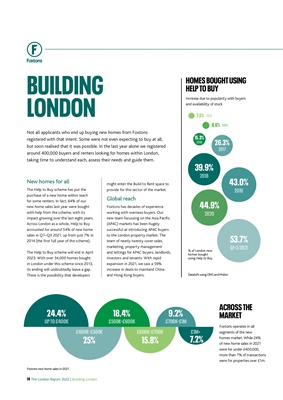
New homes for all
The Help to Buy scheme has put the
purchase of a new home within reach
for some renters. In fact, 64% of our
new home sales last year were bought
with help from the scheme, with its
impact growing over the last eight years.
Across London as a whole, Help to Buy
accounted for around 54% of new home
sales in Q1-Q3 2021, up from just 7% in
2014 (the first full year of the scheme).
The Help to Buy scheme will end in April
2023. With over 34,000 homes bought
in London under this scheme since 2013,
its ending will undoubtedly leave a gap.
There is the possibility that developers
might enter the Build to Rent space to
provide for this sector of the market.
Global reach
Foxtons has decades of experience
working with overseas buyers. Our
new team focussing on the Asia Pacific
(APAC) markets has been hugely
successful at introducing APAC buyers
to the London property market. The
team of nearly twenty cover sales,
marketing, property management
and lettings for APAC buyers, landlords,
investors and tenants. With rapid
expansion in 2021, we saw a 59%
increase in deals to mainland China
and Hong Kong buyers.
BUILDING
LONDON
14 The London Report 2022 | Building London
Not all applicants who end up buying new homes from Foxtons
registered with that intent. Some were not even expecting to buy at all,
but soon realised that it was possible. In the last year alone we registered
around 400,000 buyers and renters looking for homes within London,
taking time to understand each, assess their needs and guide them.
ACROSS THE
MARKET
Foxtons operates in all
segments of the new
homes market. While 24%
of new home sales in 2021
were for under £400,000,
more than 7% of transactions
were for properties over £1m.
% of London new
homes bought
using Help to Buy
HOMES BOUGHT USING
HELP TO BUY
Increase due to popularity with buyers
and availability of stock
18.4% 9.2%
43.0%
39.9% 26.3%
15.3%
44.9%
53.7%
25% 15.8% 7.2%
24.4%
£500K-£600K £700K-£1M
£400K-£500K £600K-£700K £1M+
UP TO £400K
Foxtons new home sales in 2021
Dataloft using ONS and Molior
2019
2018
2017
2016
8.6% 2015
7.5% 2014
2020
Q1-3 2021